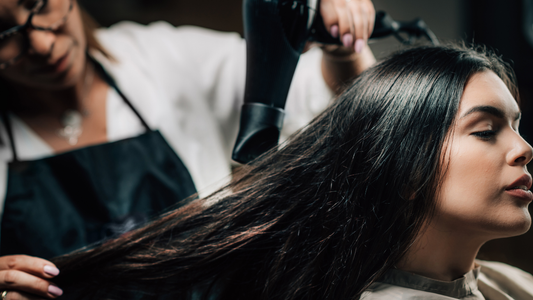Keratin treatments, like the Kera Mane Keratin Hair Treatment, offer transformative results for those seeking to smooth, strengthen, and rejuvenate their hair. However, as with any beauty treatment, it’s essential to prioritize safety before proceeding. One of the most crucial steps often overlooked is performing a patch test before applying the treatment. Patch testing is a simple precautionary measure that can prevent adverse reactions such as allergic responses or skin sensitivities.
In this article, we’ll explore why patch testing is so important, how to perform it correctly, and how Kera Mane Keratin Hair Treatment ensures safety with its gentle, effective formula. By understanding the significance of this step, you’ll be able to protect your hair and skin while enjoying the full benefits of your keratin treatment.
What Is a Patch Test?
A patch test involves applying a small amount of a product to a specific area of your skin, usually behind the ear or on the inside of your forearm. This test allows you to determine if you have any adverse reactions to the product before applying it to your entire scalp and hair. Patch tests are particularly important for treatments like keratin, which contain active ingredients that can interact with your skin.
Why Is Patch Testing Important Before a Keratin Treatment?
1. Detect Allergic Reactions:
- Allergic Responses: Some individuals may have sensitivities or allergies to certain ingredients in hair treatments. Even though Kera Mane uses natural, gentle ingredients, it’s possible to have a unique reaction to any formula.
- Signs to Watch For: Allergic reactions can range from mild irritation, redness, and itching to more severe reactions like swelling or hives. Patch testing allows you to detect these symptoms on a small, manageable scale.
2. Avoid Scalp and Skin Irritation:
- Scalp Sensitivity: Keratin treatments involve chemical processes that smooth the hair shaft. While Kera Mane is formulated to be kind to the scalp, certain individuals may have extra sensitive skin that reacts to even mild products.
- Prevention: Testing the product on a small patch of skin can prevent potential discomfort and irritation that could affect your entire scalp if the treatment is applied without testing.
3. Identify Potential Chemical Reactions:
- Previous Treatments: If you’ve recently undergone other hair treatments like coloring or perming, your hair and scalp might react differently to keratin. Patch testing helps you identify any issues caused by mixing chemicals from different treatments.
- Individual Reactions: Everyone’s hair and scalp can react differently based on factors like hair type, scalp condition, and even environmental factors.
4. Ensure Peace of Mind:
- Confidence in Application: Knowing that you’ve tested the product and had no negative reactions can give you confidence when applying the keratin treatment to your entire head. This peace of mind can lead to a more relaxed and enjoyable application process.
- Safety First: When it comes to beauty treatments, safety should always come first. A patch test ensures you’re not taking unnecessary risks with your hair or skin.
How to Perform a Patch Test for Keratin Treatment
Performing a patch test is easy and only requires a small amount of product and a bit of time.
Steps to Perform a Patch Test:
-
Choose a Small, Discreet Area:
- Pick an area of skin that is not overly sensitive but is still representative of how your scalp might react. Common spots are behind the ear or on the inner forearm.
-
Apply a Small Amount:
- Apply a small amount of the keratin treatment product to the chosen area using a cotton swab or your fingertip.
-
Wait 24-48 Hours:
- Leave the product on the skin for 24-48 hours without washing it off. Keep the area dry, and avoid applying other products on top of it.
- Monitor for any signs of redness, itching, swelling, or irritation.
-
Assess the Results:
- After the waiting period, check the patch test area for any adverse reactions. If your skin looks normal with no signs of irritation, you can confidently proceed with applying the keratin treatment to your hair and scalp.
- If any reaction occurs, avoid using the product and consult with a dermatologist if necessary.
What Makes Kera Mane Keratin Hair Treatment Safe?
1. Natural, Gentle Ingredients:
- No Formaldehyde: Kera Mane is formulated without harmful chemicals like formaldehyde, making it safer for both your hair and your scalp.
- Natural Oils and Extracts: The treatment contains natural ingredients like argan oil, coconut oil, and jojoba oil that nourish the hair while minimizing the risk of irritation.
2. No Strong Odors:
- Reduced Irritation Potential: Many keratin treatments are notorious for their strong, unpleasant odors, which can be irritating to both the scalp and the senses. Kera Mane, however, is formulated to have a mild scent, reducing the likelihood of irritation during application.
3. Dermatologically Tested:
- Backed by Testing: Kera Mane undergoes dermatological testing to ensure that it’s safe for a wide range of skin types, making it one of the gentlest yet most effective keratin treatments on the market.
Conclusion
A patch test may seem like a small step, but it’s an essential one in ensuring the safety and effectiveness of your keratin treatment. By testing for potential allergic reactions or irritations beforehand, you protect your skin, scalp, and hair from any negative consequences, ensuring a smooth and safe experience with the treatment.
Kera Mane Keratin Hair Treatment is designed with your health and beauty in mind, using natural, gentle ingredients. While it is formulated to be safe, performing a patch test is a crucial precautionary step that should not be skipped. By following these guidelines, you can confidently apply your keratin treatment and enjoy sleek, smooth, and healthy hair without any worries.




